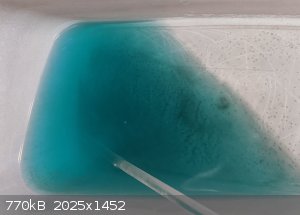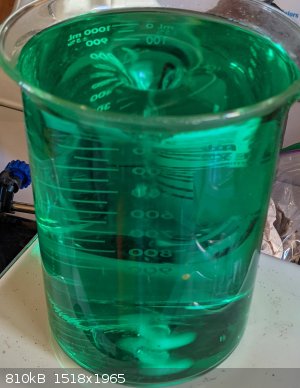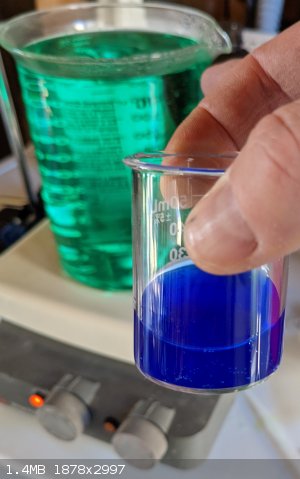inanium
Harmless

Posts: 10
Registered: 1-12-2020
Member Is Offline
|
|
peracetic acid, silver plating, and electrolysis
Hey folks,
Please excuse the noob. I had some old Farberware pieces which I think were coated in silver. They didn't have much value so I wanted to use them to
experiment with extracting and separating the metals. Rather than getting some nitric acid, I decided to try the more accessible method of soaking
them in some peracetic acid(vinegar + h2o2).
After a few days the solution turned blue and some white precipitate formed on the bottom of the container. I'm assuming the color is from copper
and/or nickel acetate, and possibly some other metal salts.
At this point I decided I would try to remove some of the copper via electrolysis. I have a standard bench power supply so I hooked one lead to one
of the Farberware pieces and another to a copper wire. I played around with the polarity and noted that if the copper wire is the cathode(connected
to the negative), I can collect what appears to be pure copper.
I was hoping this copper would adhere to the wire, but what looks to be happening is that the copper is forming thin flakes and breaking off due to
the evolved gasses at the electrode. There is also a significant 'cathode sludge' being formed.
I've dropped the voltage and current down(~2v now) to see if it improves the attachment of the copper to the wire. Is there anything else I can try
to collect more metallic copper?
Any idea what the black cathode sludge consists of?
Thanks in advance.
|
|
|
inanium
Harmless

Posts: 10
Registered: 1-12-2020
Member Is Offline
|
|
At least one of the pieces I've been working with is silver electroplated stainless steel. I'm guessing that means I now have some hexavalent
chromium in my solution in addition to everything else. I suppose that means I'll now have to treat my electrolyte as toxic waste unless I can reduce
the chromium back to a safe form.
Any tips on separating this soup are appreciated.
|
|
|
sauveurdumonde
Harmless

Posts: 33
Registered: 13-7-2021
Location: Canada
Member Is Offline
|
|
Quote: Originally posted by inanium  | At least one of the pieces I've been working with is silver electroplated stainless steel. I'm guessing that means I now have some hexavalent
chromium in my solution in addition to everything else. I suppose that means I'll now have to treat my electrolyte as toxic waste unless I can reduce
the chromium back to a safe form.
Any tips on separating this soup are appreciated. |
You may find this video useful:
"Dichromates from Stainless Steel"
Part 1/2 - https://www.youtube.com/watch?v=F_W-IyUTM5M
Part 2/2 - https://www.youtube.com/watch?v=3uzTNjuUyyk
After this process, you should have all of your metals extracted other than chromium, which you can either dispose of or make alkali metal dichromates
Please, don't poison yourself. Use proper safety
|
|
|
inanium
Harmless

Posts: 10
Registered: 1-12-2020
Member Is Offline
|
|
Thanks! Yeah I've watched that video a couple times over the years but I wasn't sure if it would apply to more complex mixtures of metals. I'll give
it a shot.
|
|
|
inanium
Harmless

Posts: 10
Registered: 1-12-2020
Member Is Offline
|
|
I think I can just slowly raise the pH with sodium carbonate and crash out the various metal carbonates at various pHs.
If anyone has any advice I'd appreciate it.
|
|
|
inanium
Harmless

Posts: 10
Registered: 1-12-2020
Member Is Offline
|
|
I took the vinegar and peroxide solution containing the dissolved metals and neutralized it with copious quantities of sodium carbonate and washed the
precipitate with water. The precipitate appeared very similar to copper carbonate and I'm sure it mostly is, albeit with iron, nickel and chromium
contamination.
I then added HCl and redissolved the precipitate to yield a pale blue liquid with a greyish white precipitate(AgCl I'm hoping). I filtered the liquid
and will process the white precipitate later. Right now I'm trying to determine the metal chlorides present in the blue liquid.
I have about 1500mL of liquid, so to reduce the volume I filled a 1L beaker and left it on a stir plate with heating. As the liquid warmed up, I
noticed a distinct color change from blue to green, with the evolution of HCl vapors(surely in excess and driven off by heat). I mixed 25mL of the
solution with 25mL of 10% janitorial ammonia and noted a deep purple color change suggesting metal complexes with the ammonia. I also noted white
mist forming when the beaker containing the mixture was placed near the heated beaker, indicating the formation of ammonium chloride vapors. After
some time, a white precipitate formed in the ammonia/chloride mixture(probably ammonium chloride).
The most interesting thing to me, apart from the absolutely spectacular color of the ammonium mixture, is the color change upon heating of the
chloride mixture. I also noticed that as the mixture cooled down the pale blue color mostly returned, although there was still a slight difference
between the 500mL of unheated chloride solution.
Does anyone have a clue as to what is happening here? Am I driving off gasses and shifting the pH of the solution and causing a color change, or is
the heat shifting the equilibrium and driving the formation of larger chloride complexes?
I suspect I'm dealing with >90% copper chloride. Do solutions of pure copper chloride exhibit behavior like this? I'd test it out myself, but
right now I'm out of glassware until I can reduce the volume of the chloride solution.
|
|
|
inanium
Harmless

Posts: 10
Registered: 1-12-2020
Member Is Offline
|
|
Pictures of the solutions attached.
  
|
|
|
inanium
Harmless

Posts: 10
Registered: 1-12-2020
Member Is Offline
|
|
Apparently the color change is just due to heat shifting the balance of the various complexes formed while in solution with free Cl ions: https://www.chemedx.org/blog/effect-temperature-chemical-equ...
|
|
|